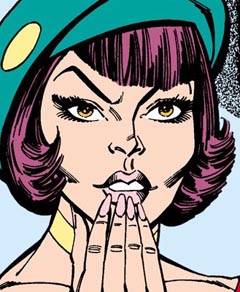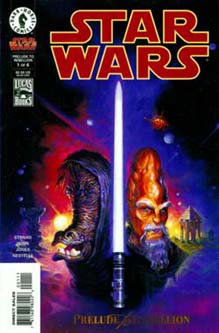As with the first series simply titled “Star Wars” (Marvel’s, from 1977-86), the second series by that name (Dark Horse’s, from 1998-2006) also gets off to a slow start. (To avoid confusion, I’ll call this series “Star Wars: Republic,” although that title didn’t appear on the cover until Issue 46.) But to be fair, Jan Strnad, the writer of the six “Republic” issues released before “The Phantom Menace” hit theaters, had a tough task: He was the first writer to unveil the prequel era to “Star Wars” fans, yet he himself probably didn’t know much more about “Episode I” than the average fan.
For “Prelude to Rebellion” (Issues 1-6), Lucasfilm allowed Strnad one new toy to play with: Jedi Knight Ki-Adi-Mundi, one of the “Episode I” council members. At the time, we knew this Cerean as the “conehead Jedi,” but Ki soon became a well-rounded character and it became easy to look past his appearance – although in the second arc, Timothy Truman’s “Outlander: The Exile of Sharad Hett” (Issues 7-12), Ki is self-conscious when a Tatooine kid makes fun of his head, and he buys a hat.
“Prelude to Rebellion” not only was released before “The Phantom Menace,” but it’s the only “Republic” series that takes place before the events of the movie. By the arc’s end, Ki has risen to a spot on the Jedi Council, although he still holds the rank of Jedi Knight rather than Jedi Master. Compensating for his shortage of prequel-era information, Strnad features Jabba the Hutt’s buddy and business partner Ephant Mon, one of many string-pullers benefitting from the underground technology market on Cerea.

Even with the disadvantages the writer faced, it must be noted that “Prelude to Rebellion” (which also includes a web-only Issue 0 by Peet Janes that has never been reprinted) isn’t very good – it introduces a lot of nuances but doesn’t explore them. Ki comes off as a hypocrite, as he supports Cerea’s ban on technology, yet he uses technology when it suits him. As he tells a critic in Issue 2: “I’ve never opposed the use of technology in the pursuit of justice. But drinking from a well doesn’t mean you wish to drown in a river.”
In addition to the planet’s tech ban leading to protests and riots and outsiders fanning the flames (the tech-loving kids, including Ki’s daughter, are labeled “tech-rats”), Ki’s viewpoint is made more confusing by the fact that we never learn why he supports the ban. Traditionalism? Environmental concerns? The planet does have a spaceport allowing for visitors and traders (Cerea is rich in a mineral found nowhere else in the galaxy, which is no doubt mined by machines), so it’s not totally averse to ships coming and going and perhaps some exhaust entering the air.
Issue 8 further hints that Ki’s concern is environmental:
“Every time I come to Coruscant and walk within its halls of living metal and breathing glass, my spirit mourns like an imprisoned child. Will my green Cerea someday be like Coruscant?”

But it’s not clear if global warming is much of a concern in the GFFA. Coruscant has clean air (thanks to technological innovations, no doubt), and that entire planet is one big city, so it seems Cerea could have both natural beauty and technology if it went about things smartly.
At any rate, “Outlander” is a huge step up for the ongoing title. From Truman’s pen, Ki becomes cooler and more likable, dropping great one-liners. After knocking a Tusken Raider attacker into a pile of poop: “I regret to inform you that bantha dung is more acceptable as cooking fuel than apparel. I just don’t think that this new look of yours will catch on.”
Truman introduces bounty hunter Aurra Sing (seen briefly watching the Podrace through macrobinoculars in “The Phantom Menace”), and I enjoy the way he writes her smirking inner monologue. She collects bounties from both Jabba and Gardulla the Hutt (“A girl works hard. Why can’t she collect two pay slips?”) while also achieving her personal objective of harassing three Jedi (Ki, and the Tusken Raider/Jedi Sharad Hett and his son, A’Sharad Hett) while also enjoying it all as a “game.”
As we learn in the 12-page black-and-white comic “Aurra’s Song,” written by Dean Motter and first published in the 2000 Dark Horse Presents Annual “Girls Rule!,” Aurra hates the Jedi because her Jedi Master, the Dark Woman (also a friend of Ki’s, and briefly his teacher before Yoda took over), sold her into slavery to Jabba. Or so she believes. The validity of this accusation will no doubt be explored in a future “Republic” arc.
I don’t remember Aurra’s Force ability being emphasized (if it was brought up at all) in “The Clone Wars,” where we last saw her as a teacher of young Boba Fett in the ways of bounty hunting. I liked Aurra on “The Clone Wars” for her coolness factor, but she seems to have a richer story in the comic-book pages.
Sharad Hett is another compelling ex-Jedi. He joined the Tusken Raiders because he regretted not seeing his mom and dad more often before they were killed. This inspired him to respectfully leave the Jedi Order, which forbids attachment, in order to join a society where he could have a kid and train him as his Padawan. Why he would choose the vicious Tusken Raiders is questionable (circumstance, I suppose), but at least it allows “Outlander” to be set on Tatooine, which in turn allows Truman and the arc’s various artists to have a blast playing with Tuskens, Jawas, Jabba, skiffs and skiff guards, banthas, dewbacks, landspeeders, and so forth.
With A’Sharad joining Ki as his Padawan, and Aurra still out there collecting bounties and loathing the Jedi Order, “Outlander” shifts the ongoing “Star Wars” title into high gear. After finishing this arc, I want more of these three characters and don’t mind one bit if Anakin and Obi-Wan remain on the sidelines.
NOTE: “Aurra’s Song” is also available in the “Rise of the Sith” omnibus.

